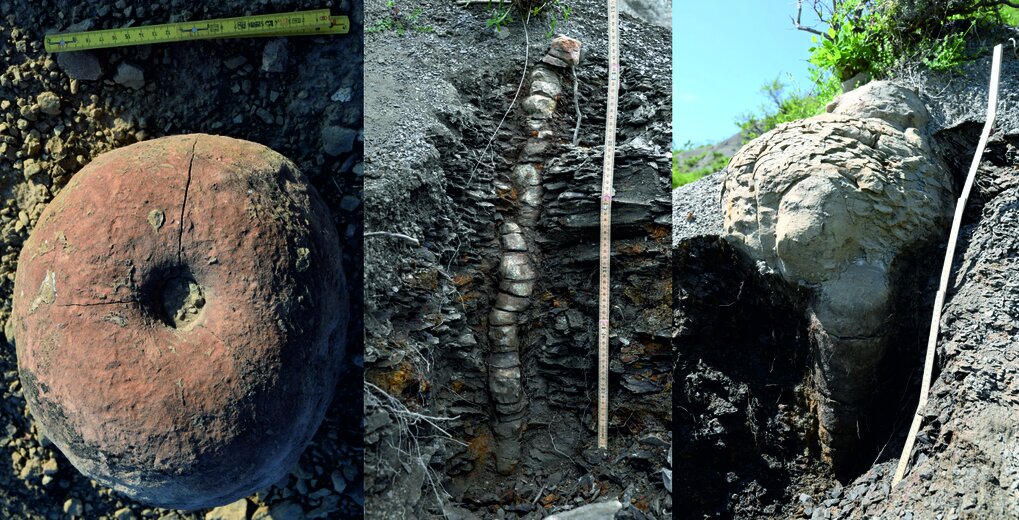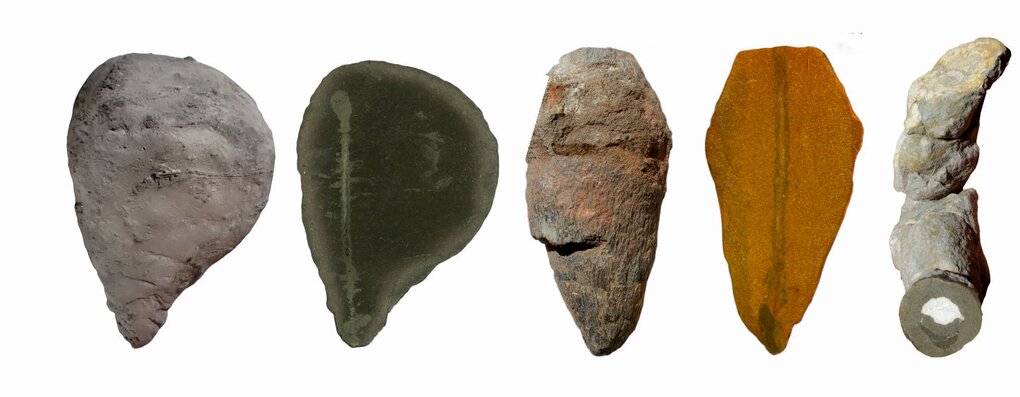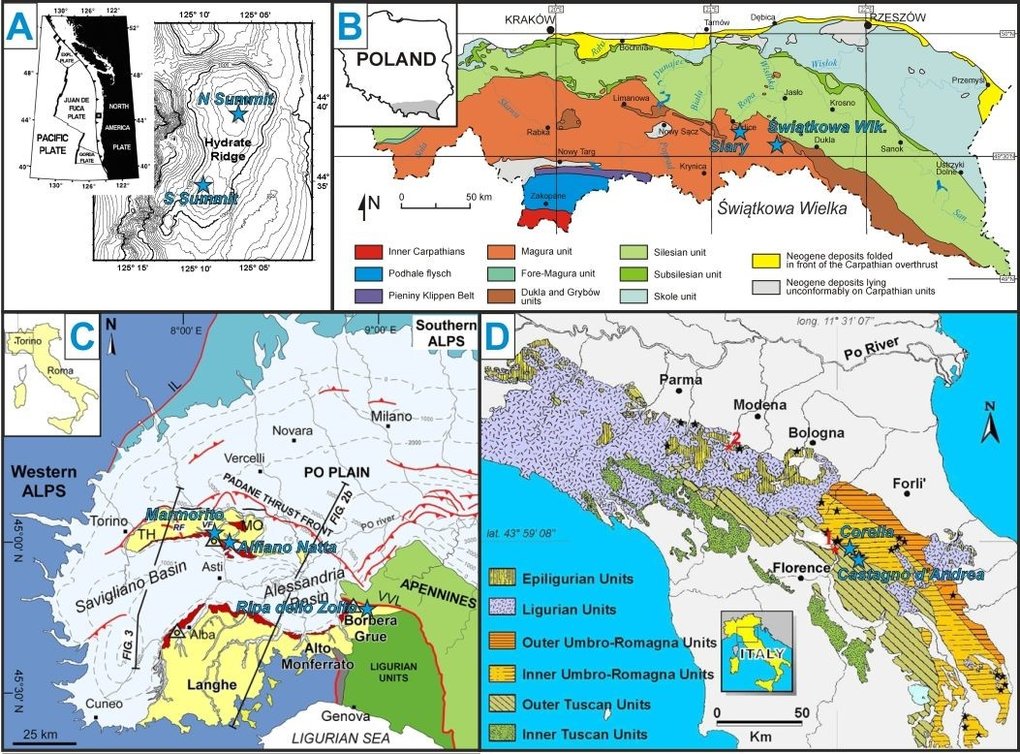

Carbonate ichnocretions as a record of the interaction between benthic activity, fluid circulation and biogeochemical processes taking place in marine clastic sediments
Research project funded by National Science Centre (no. 2024/53/B/ST10/03806)
Principal investigator: Maciej Bojanowski
Main collaborators: University of Basel, National Taiwan University, Indian Istitute of Technology Bombay, CONICET-National University of Río Negro
Project description
Concretions are the product of localized mineral precipitation in the pore spaces of sedimentary rocks. They represent isolated, usually rounded bodies originated from pore fluids circulating within the sediments. Early-diagenetic carbonate concretions (EDCCs) form by carbonate precipitation in soft and still not compacted shallow sediments. The abundant cementation produces a rigid, compaction-resistant framework that prevents mechanical and chemical destruction of primary biotic and sedimentary features. Therefore, EDCCs represent containers of paleoenvironmental data enabling reliable and detailed reconstruction of the depositional and environmental settings, especially in cold seep environments, where carbonate precipitation is fostered by oxidation of hydrocarbons. Concretions are also often associated with ichnofossils, i.e. traces of past biological benthic activity preserved in sedimentary rocks, in particular when authigenic minerals precipitated within and/or around trace fossils. The term ‘ichnocretions’ is proposed for such EDCCs. Moreover, concretionary cements are key archives of past biogeochemical reactions and fluids shallow in sediments. Despite extensive research, many fundamental issues regarding EDCCs remain poorly addressed. The main goal of this project is to enhance the applicability of EDCCs in geology by contributing to a better understanding of the following key topics related to their development through application of interdisciplinary research:
 Examples of carbonate ichnoconcretion formed around burrows
Examples of carbonate ichnoconcretion formed around burrows
Research material collected during several fieldwork campaigns will be studied with the use of quantitative X-ray diffractometry, optical microscopy, cathodoluminescence microscopy, scanning electron microscopy, electron probe microanalysis, computed microtomography, and δ13C and δ18O analyses. These standard methods will be the foundations for basic considerations and for the selection of samples for advanced geochemical investigations. U-Pb dating of carbonate cements combined with their temporal relationships with bioturbational structures will constrain the timing of the consecutive stages of carbonate precipitation from syn-depositional, through early diagenetic to burial. Clumped isotope analysis will constrain palaeotemperature and origin of parent fluids circulating in sediments during progressive burial. In-situ C and O isotope measurements in individual cement crystals using ion microprobe will be conducted in microcrystalline cements which are too fine to be targeted with micromilling. Results will allow to (1) reconstruct the concretionary growth mechanism, (2) identify the stage of concretion development when septarian fracturing and cementation took place, and (3) understand the influence of bioturbational structures and associated mucus lining on the precipitation of carbonate cements around them.
 Vertical sections through ichnocretions showing the position of the burrows
Vertical sections through ichnocretions showing the position of the burrows
Concretions and trace fossils not only represent a scientific conundrum, but also they are useful indicators of past climate and environmental changes. Burrowing of benthos in marine sediments enhances fluid transport, which may impact the climate. Such bioirrigation in cold seeps plays an important role in regulating emissions of methane, which is a much more efficient greenhouse gas than CO2. Burrowing organisms are also susceptible to environmental conditions at the seafloor. Abrupt climate-induced changes of these conditions modify abundance and diversity of benthic biota, which in turn affect sediment bioirrigation. This project offers a comprehensive research on ichnocretions from various marine settings through ichnological, mineralogical, petrographic, and geochemical investigations. Results will show what can be the consequences of climate-induced changes in benthic activity and in environmental conditions on fluid circulation, carbon sequestration through carbonate authigenesis, and methane emissions. This study will enhance our understanding of the interplay between biota, environmental parameters, and carbonate precipitation.
Project publications:
Bojanowski, M.J., Weztel, A. (202X) Sequestrichnial activity of endobenthic animals stowing food in anoxic sediments fostering growth of “gumiklyjza” concretions (Book Cliffs, Utah). Palaeogeography, Palaeoclimatology, Palaeoecology, under revision.
Wetzel, A., Bojanowski, M. (2025) ‘Resurrected’ concretions–resumed cementation after exhumation, transport, re-deposition and exploitation by producers of the trace fossil Chondrites when still being soft. Marine and Petroleum Geology 182: 107576. doi.org/10.1016/j.marpetgeo.2025.107576
Identification of clathrites in the geological record
Research project funded by National Science Centre (no. 2019/35/B/ST10/01332)
Principal investigator: Maciej Bojanowski
Main collaborators: University of Torino (Italy), University of Modena and Reggio Emilia (Italy), GEOMAR (Germany)
Project description
Methane (gas) hydrates are composed of crystalline H2O that encages CH4 gas. They are found under the seafloor along continents at specific pressure and temperature conditions (Fig. 1). Changes of pressure/temperature at the seafloor, such as ocean warming or sea-level drop, may destabilize hydrates.
Fig. 1. A) Gas hydrate of type structure I. B) Stability field of methane hydrate at normal seawater salinity. Intersections of temperature profiles (stippled lines) with phase boundary (heavy line) define the area of the gas hydrate stability zone (GHSZ). C) Inferred thickness of the GHSZ in sediments at a schematic continental margin assuming a typical geothermal gradient. A-C after Bohrmann & Torres (2006)
Widespread dissociation of hydrates may lead not only to regional disasters, such as giant slope failures, but also to global warming, as CH4 is a much more effective greenhouse gas than CO2. Indeed, some of the most severe greenhouse conditions, such as the Paleocene-Eocene Thermal Maximum and mass extinctions, e.g. the end-Permian extinction, are linked to worldwide dissociation of hydrates (Fig. 2).
Fig. 2. The end-Permian mass extinction (after Brand et al., 2016). A) δ13C excursion, faunal disappearances and gas compositions. B) Sequence of events before and during the extinction. Upper panel shows extensive Siberian Trap Flood volcanism and emission of CO2 leading to climate warming, lower panel shows the subsequent release of massive amounts of CH4 hydrate and increased global warming.
Methane-derived authigenic carbonates (MDACs) precipitate due to anaerobic oxidation of methane at cold seeps. Gas hydrates commonly occur in genetic association with and directly within MDACs, which are termed “clathrites”. Since hydrates are not preserved in the rock record, ancient clathrites represent the only direct and tangible evidence of former hydrate occurrence, so they are particularly valuable research material. Yet, reports of fossil clathrites are very rare (none in the intervals representing hyperthermal events supposedly associated with hydrate breakdown) and their recognition is clearly underestimated. The main objective of this project is to diagnose the causes of this underrepresentation and provide solutions that would enhance the recognition of hydrate-associated authigenic carbonates in the geological record.

Fig. 3. Study areas and locations of the most important sections (blue stars): Hydrate Ridge on the northwestern continental margin of North America (A - modified from Bohrmann et al., 2002), Outer Carpathians (B - modified from Bojanowski, 2014), Piedmont Basin (C - modified from Dela Pierre et al., 2012) and Northern Apennines (D -modified from Conti et al., 2010).
The research will be carried out on MDACs from one modern (Hydrate Ridge) and three ancient sections (Piedmont, Apennines, Carpathians) through international cooperation with the researchers working on MDACs in these areas (Fig. 3). Petrographic (optical microscopy, CL, SEM, EMP) and bulk δ13C and δ18O analyses will chiefly result in identification of potential ancient clathrites, for which advanced geochemical investigations will subsequently be employed. Application of ion microprobe, which enables in-situ δ13C and δ18O analyses, will allow reconstruction of growth mechanism and fluid sources for successive cement generations separately, some of which may be related to hydrates. Clumped-isotope analysis will provide the paleotemperature and δ18O values of parent fluids, which will verify which cements were related to hydrates. In-situ U-Pb dating will provide a timeframe of these processes, including those related to hydrate formation or dissociation. It will also allow constraining the depth and relative timing of carbonate precipitation at different levels of paleo-seep systems examined.
Direct outcomes of the project:
References:
Bohrmann G. et al. (2002) Gas hydrate carbonates from Hydrate Ridge, Cascadia convergent margin: indicators of near-seafloor clathrate deposits. In: Proc. Fourth Int. Conf. Gas Hydrates, 102-107.
Bohrmann G., Torres M. (2006) Gas hydrates in marine sediments. In Schulz H.D., Zabel M. (eds) Marine Geochemistry, 2nd ed. Springer, Heidelberg, 481-512.
Bojanowski M.J. (2014) Authigenic dolomites in the Eocene–Oligocene organic carbon-rich shales from the Polish Outer Carpathians: evidence of past gas production and possible gas hydrate formation in the Silesian basin. Mar. Petrol. Geol. 51, 117-135.
Brand U. et al. (2016) Methane Hydrate: Killer cause of Earth's greatest mass extinction. Palaeoworld 25, 496-507.
Conti S. et al. (2010) A contribution to the reconstruction of Miocene seepage from authigenic carbonates of the northern Apennines (Italy). Geo-Mar. Lett. 30, 449-460.
Dela Pierre F. et al. (2012) Messinian carbonate-rich beds of the Tertiary Piedmont Basin (NW Italy): microbially-mediated products straddling the onset of the salinity crisis. Paleogeogr., Palaeoclimatol., Palaeoecol. 344-345, 78-93.
Project publications:
Bojanowski, M.J., Argentino, C., Conti, S., Dela Pierre, F., Fontana, D., Giunti, S., Martire, L., Natalicchio, M. (202X) Authigenic carbonates as archives of past gas hydrates: definitions, identification, and research directions. Sedimentology, under revision.
Giunti, S., Tramm, F., Conti, S., Mottram, C., Chapman, G., Radzikowska, M., Fontana, D., and Bojanowski, M.J. (202X) New microfacies and radiometric age of seep carbonates from the Northern Apennines (Italy): Implications for hydrocarbon migration prior the Messinian Salinity Crisis. Journal of Sedimentary Research, under review.
Giunti, S., Tramm, F., Kremer, B. and Tucker, M. (202X) Carbonate spherulites in a Lower Cretaceous hydrocarbon seep (Outer Carpathians, Poland). Sedimentology, under revision.
Giunti, S. (2025) Petrographic and geochemical investigations of seep carbonates from the Outer Carpathians, Northern Apennines, and Piedmont constraining their origin, age, and relation to gas hydrate. PhD Thesis, Institute of Geological Sciences, Polish Academy of Sciences.
Giunti, S., Mottram, C., Natalicchio, M., Martire, L., Chapman, G., Pierre, F.D., Bojanowski, M.J. (2025) Using U-Pb dating of Cenozoic seep carbonates to assess periods of hydrocarbon seepage in sedimentary basins. Chemical Geology 695: 123016. https://doi.org/10.1016/j.chemgeo.2025.123016
Giunti, S., Bojanowski, M.J. (2025) Glendonites as proxy for gas hydrate in paleoseeps: Evidence from the Outer Carpathians (Poland). Geological Society of America Bulletin 137: 2999–3010. https://doi.org/10.1130/B37922.1
Bojanowski M.J., Paszkowski, M. (2025). Dissociation of gas hydrate and submarine slope failure: example from the Oligocene of the Outer Carpathians. 38th International Meeting of Sedimentology, 26–28 June 2025, Huelva, Spain – oral.
Giunti, S., Gedl, P., Kędzior, A., Marynowski, L., Paszkowski, M., Wetzel, A., Bojanowski, M.J. (2024) Hydrocarbon-derived thrombolites from the Outer Carpathians (Lower Cretaceous, Poland). Sedimentology 71: 2183-2209. https://doi.org/10.1111/sed.13212
Conti, S., Argentino, C., Bojanowski, M., Fioroni, C., Giunti, S., Kremer, B., Fontana, D. (2024) The transition from normal marine to evaporitic conditions recorded in a cold seep environment: The Messinian succession of Northern Italy. Marine and Petroleum Geology 160, 106617. https://doi.org/10.1016/j.marpetgeo.2023.106617
Bojanowski, M., Giunti, S. (2024) Vestiges of former gas hydrate in sedimentary successions. 37th International Meeting of Sedimentology, 25–27 June 2024, Aberdeen, UK – oral.
Giunti, S., Bojanowski, M. (2024) Ancient seep carbonates hosting pseudomorphs after gas hydrate and ikaite (Outer Carpathians, Poland). 37th International Meeting of Sedimentology, 25–27 June 2024, Aberdeen, UK.
Bojanowski, M. (2023) The role of gas hydrate in geological history. XV GeoSed Meeting 2023, June 28-29 2023, Turin, Italy – keynote talk.
Giunti, S., Paszkowski, M., Kędzior, A., Gedl, P., Bojanowski, M.J. (2023) Microbially-controlled formation of methane-derived, shallow-marine thrombolites from the Outer Carpathians. 36th International Meeting of Sedimentology, June 12–16 2023, Dubrovnik, Croatia, Abstracts Book, Eds. Vlahović, I. & Matešić, D., p. 342.
Bojanowski, M. (2023) Hydraty metanu w zapisie geologicznym. Polska Konferencja Sedymentologiczna POKOS 8, 5–7 września 2023, Chęciny. Materiały Konferencyjne, Eds. Bojanowski M., Jarzynka, A., Wróblewski, W., Polskie Towarzystwo Geologiczne, Kraków, 2023 , p. 113.
Giunti, S., Bohrmann, G., Conti, S., Dela Pierre, F., Fontana, D., Martire, L., Natalicchio, M., Wetzel, A., Bojanowski, M. (2022) Petrographic features related to former presence gas hydrate in ancient seep carbonates: preliminary observations on modern and fossil material. 21st International Sedimentological Congress, Beijing, China, 22-27 August 2022, T4-91248.
Giunti, S., Dela Pierre, F., Martire, L., Natalicchio, M., Bojanowski, M.J. (2022) Microfacies of methane-derived authigenic carbonates potentially related to gas hydrates: examples from the Piedmont Basin and the Polish Outer Carpathians. Congresso SGI-SIMP 2022, Turin, Italy, 19-21 September 2022, Geosciences for a sustainable future, Abstract book, Società Geologica Italiana, p. 1210.